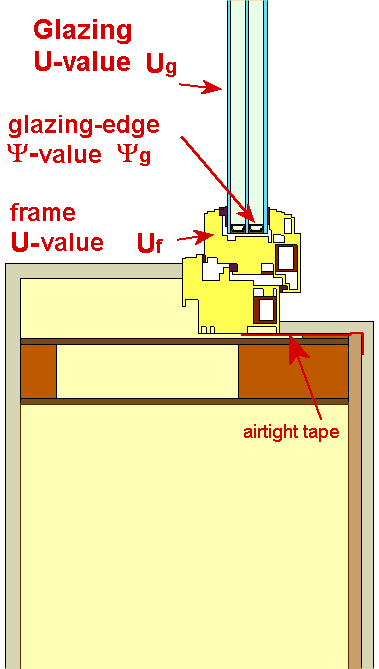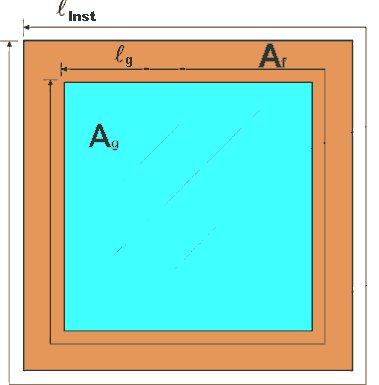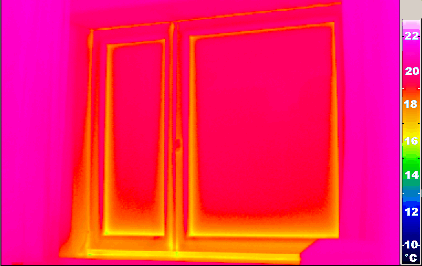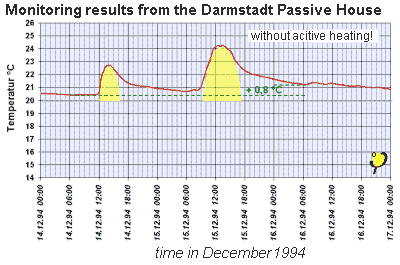Window
- Heat Transfer Coefficient Uw
and
Glazing - Heat Transfer Coefficient
Ug
The
translation of this page was made available by support of Intelligent
Energy Europe ![]()

A warm window with Uw value under 0.8 W/(m²K) guarantees very good comfort.

This diagram shows the relevant dimensions:
| Glazing surface area | Ag | (glazing) |
| Frame surface area | Af | (frame) |
| Glass edge length | lg | (glazing perimeter) |
| Frame edge length | lInst | (frame perimeter) |
Because windows have a large influence on the energy balance of a house, in order to design energy efficient houses the window u-values should be calculated using the actual glazing and frame area values. This is easy to accomplish using the PHPP (Passive House Planning Package) Doing this can prevent dissapointments with actual building performance and save money as well.

Interior thermography of a Passive House window: Most surfaces of glazing and framework are evenly warm (18 to 19°C in this picture). However there is a distinct temperature decrease along the entire edge of the glass (yellow, approx.. 16,5 to 17°C). The temperatures are still high enough to prevent condensation. But the heat losses are measurably increased in this area - therefore the thermalbridge losses of the edge of glass must be accounted for. With passive house windows special measures are implemented in order to keep these losses small: better insulating spacers ("warm edge") set deeper into the frame. (boundary conditions of the image:indoor air temperature 22 °C, outside temperature 2.5 °C; it is an image of a passive house window from the rennovation project "Jean Paul Platz" in Nurenberg. Also notable are the slightly lower temperatures at the edge of the window where it meets the wall. With non-Passive House windows, this temperature can be much lower, often low enough that condensation is present.
More at the next passive house conference in Nurenberg: www.passivhaustagung.de.
1) The climate conditions are based on Central Europe.
How does this relate to passive house
windows?
Passive House windows do
not differ from normal windows - each must be appropriate for its function
As crucial function for a passive house turns out to be the
comfort criterion: The average interior surface temperature
of the window including all connection details should not be more than
3°C less than ambient temperature during the winter "design day". Based
on these requirements, an effective window U-value can be derived for
each climate region. For Central Europe, here the winter design temperature
is approximately -10°C, this results in the following
Requirement:
Effective window U-value
should not be greater than 0.8 W/(m²K).
Passive house windows therefore are approximately two times better than
typical new windows in Europe. Due to the low heat losses, the internal
surface temperature during cold nights in Central Europe stays above
17 °C. Even during these cold outdoor temperatures, occupant comfort
within the proximity of the window is excellent: There is neither "cold
radiation" from the window, or unpleasant pool of cool air at the floor.
For more information on the topic of thermal comfort see the page "passive
house comfort".
The thermal losses or U-value for the entire window is critical. This
value is affected by the glazing type, frame and spacer (see fig. on
the left side). Passive Houses cannot usually be obtained using windows
with worse U-values.
For
determining window U-values, there is a European-wide standard: EN 10077.
The values determined according to this standard turned out to be realistic
- because the standard also considers the thermal bridging effect of
the glazing spacer. This was not the case in old procedures, which is
why old procedures often determine much too small specific losses. Do
not use these old values, e.g. kF ("old German window k-value").
To calculate the window U-value Uw , EN 10077 uses:
- the glazing U-value Ug
and the surface area of the glazing Ag,
- the U-value of the frame
Uf and the surface area of the frame
Af
- the thermal bridge coefficient
at the edge of glass Ψg (essentially
determined by the spacer) and the glass edge length lg
- also included is the thermal bridge due to the installation of the window in the exterior wall ΨInst and the length lIns where the window meets the wall.
In order not to have accurate window characteristics it is crucial to account for all heat losses specified above. This is accomplished using the formula
Ag Ug + Af Uf + lg
Ψg (+ lInstΨInst ) |
||
| Uw = | ||
Ag
+ Af |
||
The linear thermal bridge at the edge of the glazing plays a large role; if one neglects it, the results are much too optimistic. The illustration on the left shows how large the edge influence is
With the inclusion of the installation thermal bridge, indicated in parentheses, all window losses are accounted for. The above calculation is part of PHPP (Passive House Planning Package). The individual values used in the formula, are well-known for each passive house window. These windows are Certified by the Passive House Institute. Strict requirements apply for this certificate - the indicated values must be proven by the manufacturer. Only then may a manufacturer use the Passive House Institute Quality Approved label:
![]() Passive house suitable window.
Passive house suitable window.
At
the same time a window allows both direct and indirect sunlight into
the building. The Solar Heat Gain Coefficienct "g"
indicates what amount of the incident perpendicular solar radiation
that passes through the glazing. Passive house windows need to have
a positive energy balance in the winter,
i.e. it is required for the glazing that:
Ug - 1.6 W/(m²K) · g < 0
If this condition is fulfilled, then the amount of solar energy harvested by the windows is greater than their losses.
Unlike typical windows, Passive house windows are not just an additional
source of energy loss, in fact they are a source of energ gain. This
applies as long as the window is not excessively shaded and is oriented
predominantly to the south (in the northern hemisphere). The following
diagram shows this effect in practice.

Passive
solar in practice: Nothing shows more
impressively the effectiveness of the passive solar energy use than
measured values from the passive house Kranichstein: In December 2004
no heating was needed in this house. On the two sunny
days, the 14th and 15th of December, the glazing lets solar energy inside
and the indoor temperatures visibly increase (yellow phases). The thermal
mass of the house is loaded. Since the heat losses are very small, the
house can hold this heat. On the 16th of December at 6:00 AM, the temperature
is 0.8 degree higher than on the 14th of December, before the sun came
out. As it typcally occurs in the Central European Region, the following
days were unfortunately very cloudy. Nevertheless, this house loses
only about 0.2 degree per day without heating.
(click on the diagram for a a
more higher resolution version)
Thank's to the Hessian State Government for financing the documented measurements.
Today the expected solar heat gain can be calculated quite
exactly when planning with the PHPP (Passive House Planning Package).
Result
Important are both of the following values:1)
- The window U-value
as a measure of the heat losses; above all, because the window is
not to have an unpleasantly cold surface during the winter. The U-value
should be as small as possible, but at least smaller than 0.8 W/(m²K).
- The glazing g-value as a measure for the possible solar heat gain. The g-value should be reasonably high; values around 0.5 are now typical.
Of course it is preferable if the window has only a small frame portion. However, it should not be reduced so much that it compromises the U-value.
Find
additional information on Passive House Windows.
12. Passive house conference
Passive house windows of various designs may be seen at the Exhibition. By the way: these leading edge German windows construction are also well suited for use in the rennovation of existing buildings.
This link leads to basic information about passive houses.
Click the logo to visit the Passive House Institute homepage: ![]()
(revised:
2006-05-01 author: Dr. Wolfgang Feist
unchanged
copy permitted - please give reference to the source
thanks to David Stecher for proof reading)